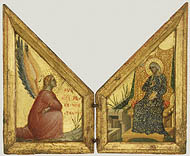Grades/Level: Upper Elementary (3–5), Middle School (6–8), High School (9–12) |
||||||||||
Activity Overview |
||||||||||
Students search for angels and demons within the paintings in the medieval and Renaissance galleries at the Getty Center. They examine the ways that artists made these invisible creatures visible. |
||||||||||
Learning Objectives |
||||||||||
Students should be able to: |
||||||||||
Materials |
||||||||||
• Seeing the Invisible: Angels and Demons worksheet |
||||||||||
|
||||||||||
Activity Steps |
||||||||||
1. Take students to the upper level of the Museum's North Pavilion at the Getty Center. |
|
|||||||||




